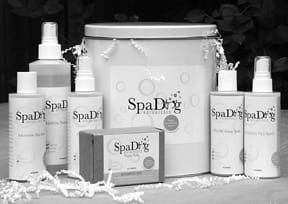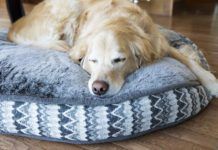Aromatherapy. Ten years ago, few people in the U.S. knew what it was, much less its canine applications. Today, hundreds of pet products contain essential oils or have “aromatherapy” on their labels. However, many people only associate aromatherapy with strongly scented candles or perfumed air sprays.
“That’s recreational aromatherapy,” says Kristen Leigh Bell, whose book Holistic Aromatherapy for Animals was published two years ago. “What Americans are just beginning to learn is that aromatherapy is actually a branch of medicine. In fact, in France, where the healing effects of essential oils were first documented, only licensed medical doctors can practice aromatherapy.”
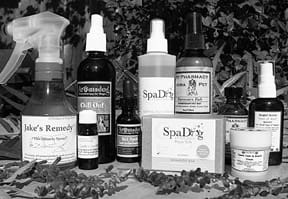
Aromatherapy utilizes essential oils and their byproducts, most of which are produced by the steam distillation of a plant’s seeds, blossoms, fruit, leaves, stems, or roots. Ironically, while the term implies that fragrance plays an important role in the healing process, a plant’s aroma has less to do with the therapeutic properties of its essential oil than the oil’s small molecular size (which easily penetrates body tissues) and unique pharmacological properties.
There are essential oils with antibacterial, antiviral, and/or antiseptic effects. Some have a calming influence; others are stimulating. There are essential oils that improve circulation, act as a diuretic, repel fleas and ticks, improve digestion, reduce inflammation, relieve congestion, elevate one’s mood, stimulate hair growth, prevent motion sickness, enhance immunity, improve focus and concentration, speed wound healing, improve endocrine function, or facilitate detoxification – and, because the chemistry of plants is so complex, they may do several of these things at once. Truly, the emphasis in the term “aromatherapy” should be on “therapy.”
Innovations in Pet Aromatherapy
Essential oils can be sprayed into the air, applied to a pet’s bedding or clothing, or diluted and applied to the fur or skin. Because aromatherapy is such a complex subject, having experts design products for us is a time-saving convenience. Some large corporations make aromatherapy products for dogs, but the most interesting developments are coming from small manufacturers.
One is Cathy Franklin, a cosmetologist in Visalia, California, who came to aromatherapy by way of a perfume blending workshop. Her training included a year-long diploma course at the Michael Scholes School for Aromatic Studies, where she learned about canine applications for essential oils from Joan Clark, who was then Scholes’ partner.
Cathy’s Pet Potions line, which debuted in 2003 at the opening of a dog park, includes four mist products, a shampoo, a dry shampoo, and a conditioner. “The dogs loved them,” says Franklin. “We couldn’t keep them out of our booth. They kept jumping on the table and climbing under it.”
Rather than use emulsifying agents, Franklin sells essential oil blends in small glass bottles accompanied by larger spray bottles. A dog owner puts an ounce of pure water in one of the large spray bottles, adds three to five drops of essential oil, and shakes the bottle before spritzing. “I want to keep the sprays as pure and organic as possible without adding anything that might cause irritation,” says Franklin. “Another way to use the blends, which is what I prefer, is to place a drop or two on your hands and run your fingers through the dog’s hair. This works very well, and it’s ideal for dogs who don’t like sprays or misters.”
Franklin uses organic essential oils in all her products. “Essential oils are like fruits and vegetables in that their quality is graded, and I always buy the highest,” she says.
Tara Fleming in Reedley, California, swears by Cathy’s Pet Potions Relaxation Oil. “I use it on myself and my dogs before we compete,” she says. “It helped relax my young German Shepherd at her first agility trial, and she finished her title in one day!”
Joan Clark, Franklin’s teacher, became interested in aromatherapy for animals in 1990 when Mattie, her two-year-old Cocker Spaniel, became disabled. Clark had studied aromatherapy for humans in the 1980s with a series of internationally known instructors, including Marcel Lavabre, Michael Scholes, and Daniel Penoel. When Lavabre and Scholes went into business in California, Clark joined them, and for 13 years, trained students from around the world at the Michael Scholes School for Aromatic Studies. But it wasn’t until her own dog suffered a serious injury that she considered adapting her knowledge for pets.
“A little kid sat on Mattie and broke her back,” explains Clark. “The vet recommended that I put her down. Instead, for six months I slept on the floor with Mattie, massaged her, gave her flower essences, got her off pain medication, and carried her on walks so she could relieve herself and enjoy being outside. The time she seemed happiest was in a nearby park where she rolled in a bed of wild peppermint. One day when we came home from the park, I set her down and she stood on her own. That’s when I began to appreciate the natural pain relievers in peppermint, and it was the start of Mattie’s dramatic recovery.”
For Mattie, Clark blended peppermint essential oil with jojoba and other ingredients in a massage oil; this later became Clark’s first canine product. Mattie lived to be 14, and was lively and active to the end.
Today, Clark runs Palais Aromaetica, an herb and aromatherapy business in Lawrence, Kansas, with over 40 products in its Pet Aromaetica line. Clark says she uses plants and essential oils that help correct common imbalances such as problems with the immune system, arthritis, allergies, hot spots, fleas, and ticks, or emotional issues such as anxiety, depression, hyperactivity, or a lack of mental focus. She also offers nontoxic products for cleaning everything in the house, including pet bedding, plus products for tooth cleaning and grooming. “We try to address every aspect of the animal’s life. It’s a holistic apothecary approach,” she says.
Paying for Quality Oils
Faith Thanas is another experienced aromatherapist who developed a canine division of her product line after her dogs experienced health problems. The project started in 1994, just after she completed an aromatherapy certification course, when she and her family (including two dogs and two cats) moved from New England to the Virgin Islands.
“Put northern animals in a tropical climate and all kinds of things happen,” Thanas says. In no time, her Bichon Frise developed flea allergies, a lick granuloma, and hot spots. To relieve these symptoms, Thanas started making her own formulas, and the dog’s brilliant white fur grew back quickly.
After four years in the Virgin Islands, during which she became an expert on all types of fungal infections, insect bites, and injuries, Thanas and her family returned to Massachusetts. One of her dreams was to sell her products in pet supply catalogs and through as many distributors as possible. To help make this possible, she recruited eight veterinarians in three states to test the products at their clinics.
The tests went well, and the result is AromaDog, a division of Silk Road Oils. Thanas says her AromaDog blends are sold in Japan, Canada, and the U.S., including through the KV Veterinary Supply catalog. “Chill Out is our number one seller. It’s a spray mist containing sweet marjoram, lavender, Roman chamomile, and other ingredients that you spray in the air. It calms hyperactive dogs, alleviates separation anxiety, and helps reduce chronic barking and even thunder phobia. Rescue group and veterinarians use it around their cages and in their waiting rooms, and groomers report that it helps dogs relax and stay calm even when things get hectic,” Thanas says.
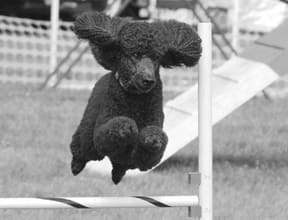
Guardians should be forewarned that, just like supplements and herbs, the best aromatherapy products are not inexpensive. But as Thanas points out, “High-quality aromatherapy products save a lot of money in the long run. Despite what people may think when they see AromaDog products for the first time, ours is a serious company in a serious business. Even our colognes are immune system stimulants. As consumers and veterinarians, including conventional veterinarians, become familiar with our products, they realize that there’s a lot more to aromatherapy than a pretty smell.”
Let the Dog Pick Her Own Oil
For Littleton, Colorado, aromatherapist Frances Fitzgerald Cleveland, the most important part of a canine aromatherapy treatment is letting the dog choose his or her own essential oils. Like all of the aroma-therapists interviewed for this article, Cleveland offers private consultations and custom blending through her business, Frog Works. After learning about a dog’s case, she selects a handful of essential oils and sends them to the dog’s owner, with instructions explaining how to offer them so the dog can demonstrate his or her preference.
A five-year-old Standard Poodle named Beatrice was one of the many beneficiaries of this system. While playing in the Boston Arboretum with other dogs in 2003, Beatrice broke her calcaneal (hock) bone. The multiple fractures required pins inside and outside the leg for six weeks and the wearing of a cast for another four weeks.
“Just three days before the accident, she achieved her Excellent Agility title,” says her owner, Shelley Brauer. “The surgeon doubted that she would ever again have enough range of motion to jump properly.”
A friend in New Mexico saw a newspaper article about Cleveland’s aromatherapy work with animals at the Denver Zoo and sent it to Brauer. “I wanted to help Beatrice heal both physically and emotionally,” says Brauer. “In addition to being badly injured, she developed separation anxiety and seemed terrified to be left alone with that apparatus on her leg.” Cleveland’s aromatherapy sounded like something that could complement the conventional medical treatment that Beatrice was receiving.
After a consultation with Beatrice’s owner, Cleveland determined which essential oils would work best for Beatrice and sent seven diluted oils for her consideration: peppermint, sweet marjoram, rose otto, violet leaf, yarrow, neroli, and grapefruit. After ignoring all of them for days, Beatrice began to show an interest in violet leaf. When Brauer put a drop on her hand, Beatrice licked it. “She lets us know that she wants her aromatherapy massage session by going into the room where the bottles are kept and looking at them,” Brauer says. “As her recovery has progressed, she has also become interested in rose otto, which helps her deal with emotional stress.”
Seven months after the accident, Beatrice’s surgeon examined her hock’s range of motion and called it “amazing.” She recently won two blue ribbons in an agility competition.
Diluting Essential Oils for Dogs
Canadian aromatherapist and canine massage therapist Teresa Mazzella began blending products for dogs when her two young Boxers developed allergies, sensitive skin, pyoderma, and other ailments. Based in Leamington, Ontario, her AngelScent product line is growing fast, and its best-sellers are grooming sprays: “Bug Me Not” for repelling insects, “Canine Calm” for relaxation, and “Relief Cream” for sore muscles and arthritis.
“The most important advice I can offer,” says Mazzella, “is to dilute, dilute, dilute. It’s a mistake to assume that essential oils can be used on dogs the same way they are used on humans. And because dogs come in so many sizes, it’s important to dilute essential oils even more for small dogs and puppies. I make blends for dogs over 30 pounds and more dilute blends for dogs under 30 pounds as well as for very young dogs. Essential oils are concentrated, so tiny amounts of therapeutic-quality oils are highly effective.”
Proof is in the Effectiveness
Before blending products for dogs at Happy Tails Canine Spa in Los Angeles, Lorna Paxton worked in the human health and beauty industry doing marketing and product development. “Knowing about manufacturing standards and ingredient information has helped a lot,” she says. To learn about essential oils, Paxton studied at the Pacific Institute of Aromatherapy.
“One of our most popular products is Calming Aromatherapy Spritzer,” she says. “It’s a detangling leave-in conditioner with chamomile and lavender that has a relaxing effect on dogs, even if they’re excited about traveling in the car or distracted by a trip to the vet. If you apply it before giving your dog a bath, her coat will be easier to brush out after, or you can apply it after bathing for improved conditioning. It can also be sprayed onto mats and tangles for effortless brushing.”
In addition to their essential oils, Paxton’s grooming products contain Ordenone, a water-based compound that binds with and removes the mercaptans, amines, sulfides, and acids in awful-smelling organic compounds, neutralizing even the worst doggy odors at their source.
With her marketing background, Paxton focuses as much on her products’ appear-ance as their ingredients. “It’s important that a product look good, smell good, be easy to use, and contain carefully thought-out ingredients that are themselves organically produced or of the highest quality. But it’s most important that the product work effectively,” she says.
Getting the Purest Oils
Sometimes people turn to aromatherapy products for what isn’t in them. Manufacturers of pet products are not required to disclose their ingredients, so many list only a few appealing ingredients, omitting the synthetic or lower-cost constituents. The makers of the best aromatherapy products use just a small number of select ingredients – and proudly disclose each and every one of them.
“I encourage everyone to ask more questions of manufacturers,” says Sevi Kay, founder of Mundo LLC, in Millersville, Maryland. Mundo makes aromatherapy sprays, shampoos, and conditioners. “I want people to insist that manufacturers disclose what’s in a product. Manufacturers who use the highest quality ingredients and are proud of their training and expertise should be willing to share this information.”
Full disclosure was exactly what Lori Moreland was looking for when she was searching for a product for her four-month-old Newfoundland puppy, Magic. Not long after she received the last of her puppy vaccines, Magic broke out in a fit of blisters, sores, flaking, hair loss, and itching. As the owner of a pet supply store/salon, Pet Empawrium in Arvada, Colorado, Moreland had access to a variety of shampoos but found that none of them helped – in fact, they made the conditions worse.
As she searched for products that could help relieve Magic’s discomfort, Moreland focused on those that were pure and free of potentially harmful chemicals. It was then that she realized that her salon’s “natural” shampoos contained unnatural detergents, foaming agents, and unnamed “proprietary ingredients.” Even though she was a retailer of these products, none of the manufacturers would reveal what was in them.
“That’s when I got to know Sevi Kay and her Mundo line of shampoos,” says Moreland. “Sevi fully disclosed all the ingredients in her products. I tried the lavender just two days after Magic’s last irritating bath, and the results were astonishing. The itching ceased immediately, and within days, a year’s worth of sores were healing and new fur was growing where she had been bald.”
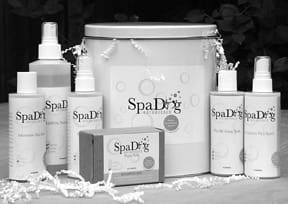
Moreland has continued to use Mundo’s products on Magic, to great effect. “Magic’s coat is now as thick, black, and shiny as any I have ever seen. I still bathe her every one to two weeks, depending on her swim schedule, but her coat is never dried out or flakey. The sores have been gone for almost a year,” says Moreland.
Pure, high-quality products like the ones discussed in this article are effective in helping dogs like Magic heal, and in not causing adverse reactions. This combination can be key for dogs with chemical sensitivities.
Therapeutic Dog Grooming
San Francisco resident Sharon Mueller founded Spa Dog Botanicals with help from aromatherapist Andrea Warren, who manufactures several aromatherapy product lines in Kansas. Mueller and Warren spent eight months designing, developing, and testing ingredients and blends before introducing 15 Spa Dog grooming products that have specific therapeutic uses. Each product’s blend of essential oils determines its overall effects. Spa Dog’s most popular product is “Smell Sweet Soothing Ear Care,” a blend of distilled water, aloe vera, vitamin E, organic cider vinegar, and essential oils that help soothe, heal, and prevent ear infections. Several products are age-specific.
“For example, we use a lot of warming blends for older dogs to help lift their spirits and keep them moving,” says Mueller. “We use antiviral blends for puppies and younger dogs, and for active adult dogs, we emphasize calming oils, like lavender and chamomile. We sell age-related products as kits, so it’s easy to start with the right combination of shampoos, soaps, ear cleaners, and sprays.”
Spa Dog’s products contain only natural ingredients and essential oils – nothing synthetic, says Warren. Additionally, some (but not all) of the ingredients are organic. The soap base is an olive oil soap; Spa Dog uses no sodium lauryl sulfate (SLS).
Also With This Article
“Therapeutic Essential Oils for Your Dog”
Healing Oils for Your Dog
-CJ Puotinen is author of The Encyclopedia of Natural Pet Care and Natural Remedies for Dogs and Cats. She has also authored books about human health including Natural Relief from Aches and Pains.


